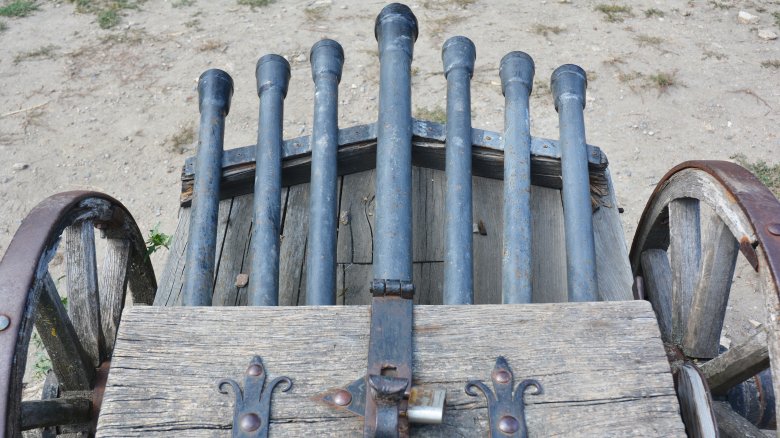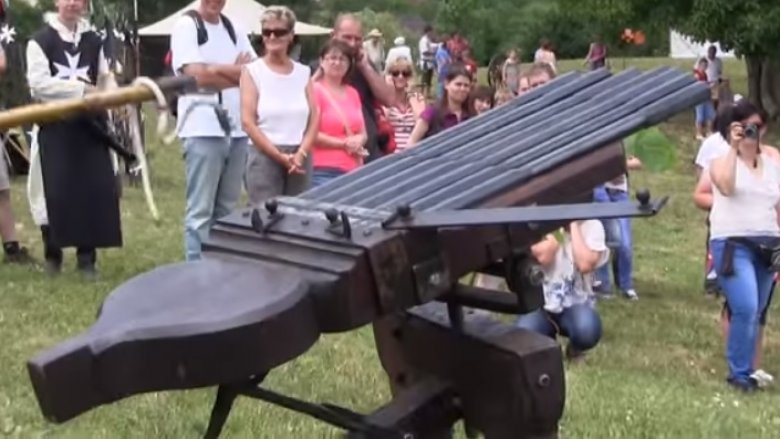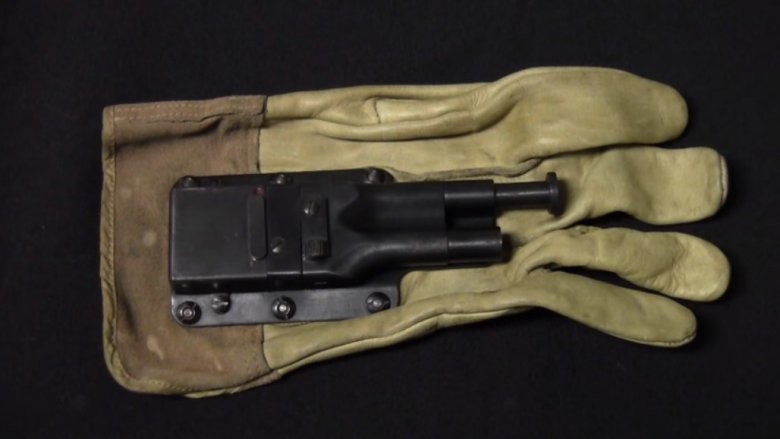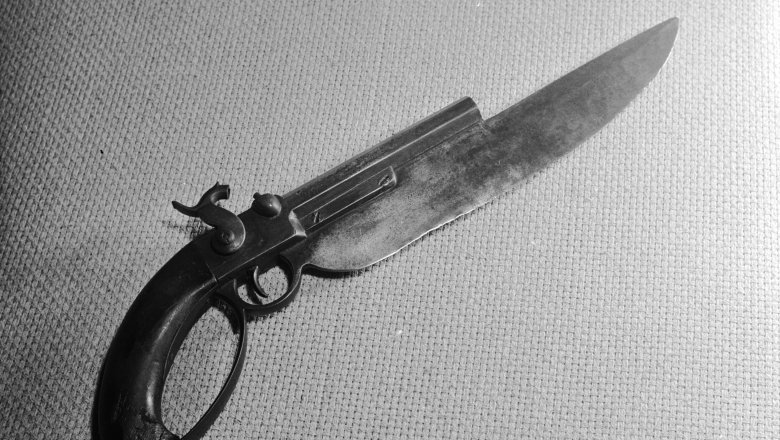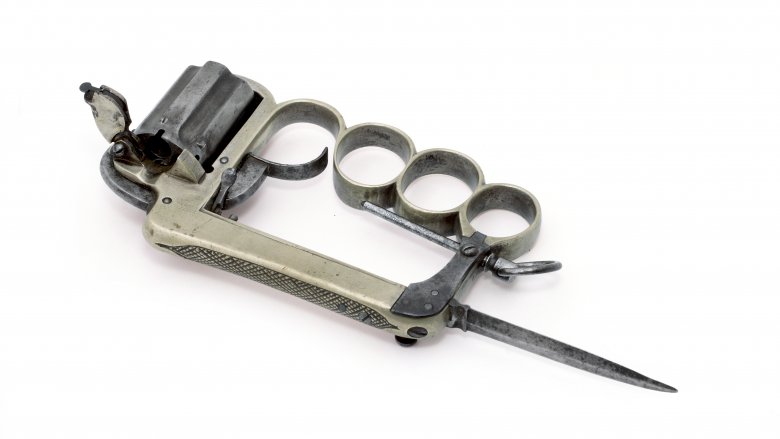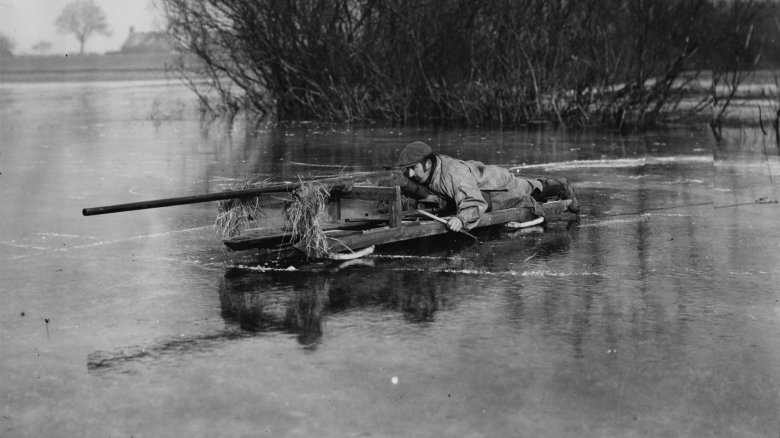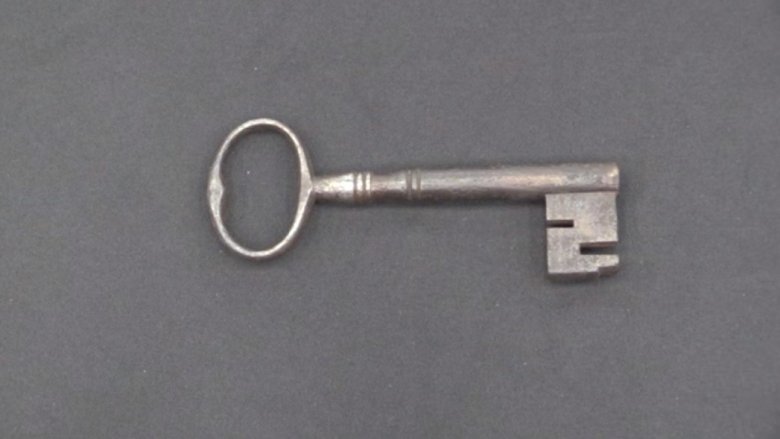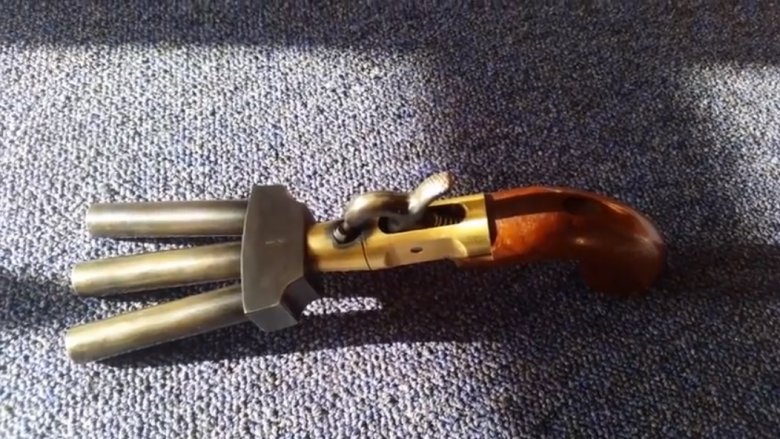The Most Bizarre Guns You've Never Heard Of
Boring, plain pistols and rifles certainly work in a pinch, but if you want pizzazz, you need to look past the sporting goods section at your local Walmart. There's a veritable bevy of weird, bizarre, and downright goofy guns out there, perfect for when you want a little variety during your next afternoon at the shooting range.
The ribauldequin had cannons for days
Introduced in 1339 by England's King Edward III, the ribauldequin was an early attempt at rapid-fire weaponry. As described by The Vintage News, It was a mini tank with up to a dozen cannons sticking out of it. The user would load each cannon up with lead balls, light them up, and let them rip all in a row, like if the Radio City Rockettes all had Planet Terror legs.
Over time, England realized the ribauldequin would be so much sweeter if each one had even more cannons, so during the Italian Wars and the War of the Roses, these guns sported up to two dozen cannons each. When armies had a whole bunch of them on all sides of their wagons, they were borderline unstoppable.
There was just one issue: loading the things. Each cannon had to be muzzle-loaded separately after each shot, which is tedious at first and then deadly the longer you stand there. The guns ultimately faded from use, but they're still around in case you're putting on a show, or if you're honoring someone with a 21-gun salute and don't have enough guns to go around. Just pick up a couple ribauldequins and fire away.
The Haight fist gun let you punch and shoot at the same time
Quentin Tarantino's Inglourious Basterds wasn't the most accurate history movie (nor a very good one for learning to spell), but Tarantino did get two things absolutely right. One, Hitler deserved to die. Two, that glove gun they used was very much a real thing.
Called the Haight fist gun (or the Sedgley OSS glove gun), it was exactly what the name implies: a small .38 pistol attached to a glove that you could fire without having to worry about holding anything. It wasn't invented for kicks, but for surviving World War II. According to Guns.com, in 1943 U.S. Naval excavators would often get ambushed by Japanese soldiers as they worked to clear out jungle space for their airfields and bases. Since these workers couldn't exactly work while holding a big gun, the Navy developed a tiny gun attached to a glove. That way, if Japanese forces invaded, the workers would just ball up their fist and open fire, like when little kids pretend to be Mega Man, only lethal.
Good luck getting one for the weird gun nut in your life, though. It appears the Navy never mass-produced the fist gun, only making around 50 in total. After World War II, they seemingly decided that gloves and guns should be separate entities. You can see one at the National World War II Museum in New Orleans, but don't try to make off with it. Stealing is bad, and who knows what the guards have hidden in their gloves?
The Elgin cutlass pistol let you bring a gun to a knife fight
Fans of Final Fantasy VIII remember Squall's Gunblade: a giant sword that also functions as a giant gun. Amazingly, real life beat the video game to the punch by about 160 years, and the real version was actually something humans could hold without shattering their wrists.
As described by the Smithsonian's National Museum of American History, the Elgin cutlass pistol was a .54-caliber pistol sporting a bushy beard made out of a Bowie knife. At the time, it was perhaps the best way to ensure both the long-range and short-range advantage in battle, since you could now stab and shoot someone. It was actually designed by George Elgin, the guy who patented the Bowie knife in 1837. Gun manufacturer C.B. Allen worked with Elgin to produce the Elgin pistol, and the Navy soon realized they could do something with these knife-pistols. When the military wants your invention, you know you've made something good.
Well, good to a point anyway. The Navy commissioned 150 cutlass pistols for sailor use, but apparently no more after that. Even back then, a cutlass pistol was more a novelty and curiosity than anything else. It might've worked, but no better than a regular gun or a regular knife would. Still, if your party needs a conversation-starter, this is it. Just know that using it will ruin the party.
The Apache revolver had no idea what it wanted to be
Having a knife and gun in one is pretty awesome, but the Apache revolver (or knuckle-duster gun) takes things just one step further. Not only do you have a knife and gun, but now you have brass knuckles. Basically, unless your opponent wields a flamethrower, this gizmo will help you be ready for any kind of fight.
The Apache was made in Belgium in the early 1900s, and everything about it is an exercise in weaponized zaniness. The gun has no barrel, sending the bullet through a hole in its upper frame. The bayonet isn't as large as the Bowie knife's blade, making it easier to conceal pre-attack. And the brass knuckles are, well, the handle of a gun shaped like brass knuckles. Oh, and it was all retractable, like a Swiss Army Knife. You could fold the whole thing up and keep it in your pocket, and later open it up into a gun, a knife, knuckles, or a gloriously whacked Triple Threat Match starring all three.
Not too many Apache revolvers were ever made, so the ones that do exist are pretty valuable. According to Guns and Ammo, a revolver went for $2,850 at a 2013 Rock Island auction. Sure, you could just buy all three parts separately for a couple hundred bucks total, but where's the fun in that?
The punt gun was Duck Hunt on steroids
Think of the silliest, most comical-looking gun you can. No matter what you came up with, there's no way it was as funny as the punt gun, which was just like a regular gun, only never-ending.
In the late 1800s and early 1900s, hunters who needed to kill many birds at once used the punt gun, the barrel of which usually measured anywhere from 11 to 13 feet. And as you can see, it wasn't a light, thin gun either. This thing was a heavy-duty monster, typically weighing 250 pounds or more. According to Mashable, it could fire off more than a pound of shot in one go. It was so powerful, most hunters had to affix it to the boat they were on. Simply carrying it around required two or three people. Each shot produced enough recoil to send the boat back several inches or more, and there are reports of over 90 birds dying from a single trigger pull. It was basically a bomb for people who didn't feel like carrying around bombs.
As you might expect, officials (not to mention bird rights activists) quickly grew squeamish about the punt gun. By the mid-1800s, they were banned in much of the U.S. Nowadays, you'll see them as part of the entertainment at state fairs and gun shows, but they're pretty rare otherwise, much to the relief of feathered friends everywhere.
The key gun was a smoking prison guard's best friend
The key gun didn't get its name for any poetic reason. Rather, its makers called it that because it was a key that was also a gun. Considering the situation they were designed for, there was no time for subtlety.
One of humanity's weirder ideas, the key gun was a key given to jailers in the mid-1800s. The idea was if a prisoner tried to escape, the gun part of the key gun would make short work of the plan. The jailer would light a cigar, or some other ignitable object, press the smoldering part to a hole in the key's neck, and that would cause the gun to fire. And now you know where Bugs Bunny got the idea to turn his carrot into a weapon.
There's not much evidence of the key gun being used all too often, and for good reason. As Forgotten Weapons points out, the cigar-lighting thing is only a theory — no one's completely sure how a key gun was actually lit. In addition, as explained by Guns.com, a small gun shaped like a key was likely a prime candidate to be snatched up by prisoners and used against the guard, not to mention used to open up other jail cells. Few of these skeleton-making keys survive to this day, and considering their drawbacks, you shouldn't expect a key gun revival anytime soon.
If you like it, then you should've put Le Petit Protector on it
Le Petit Protector might not be the strongest gun in the world, but it's almost certainly the cutest.
The Little Protector gun, invented in 1820s France, is just that: a tiny pistol — not much bigger than a fingernail — that you wore like a ring. Your thumb would typically pull the trigger and fire the gun, but good luck killing anybody. The firepower of such a teeny gun was so weak that the typical shot could only penetrate one side of a tin can, according to Guns.com. But it would definitely get someone's attention.
In addition, reloading Le Petit Protector was enough to make anyone beg to pardon their French. You had to take a tiny screwdriver to remove the cylinders from the gun. Each one was filled with a new cartridge, then placed back onto the base. That's the opposite of a firefight, so you can see why Le Petit Protector, as adorable as it was, didn't stick around for very long. But that doesn't mean people don't want it — in March 2016, the auction site Catawiki got a hold of one and sold it for an incredible $7,543. While that may seem like an exorbitant amount of money for something even the auctioneer described as a "fantasy piece," it's really not that bad a deal. They did include the screwdriver, after all.
The harmonica pistol made criminals sing the 'I'm Dead Blues'
While you won't get to play any music on the harmonica pistol, its makers and users still called it that for a very good reason: The weapon looked like it had been crossbred with an actual harmonica.
According to Range365, the early 1800s found gun owners tiring of constantly reloading their weapons after every shot. But rather than just inventing a multi-chamber pistol on Day One, they traveled a few goofy side roads before stumbling on what worked. The harmonica pistol was one such silly experiment, featuring a long metal slide with multiple bullet chambers. You inserted the slide into the gun and after each shot, slid it in further so you could fire again. It looked very much like your gun was playing the harmonica, and suddenly reloading stopped the literal bang-bang boogie far less often.
In the beginning, you had to move the pistol's slide manually, lining each chamber up perfectly with the barrel. Later models let you automatically move the slide forward, making it easier to pump lead into whatever (or whoever) needed a good lead-pumping. But all the improvements in the world couldn't make the pistol less clunky and awkward to hold, and once people figured out how to get all the bullets into one chamber, the pistol became nothing more than an outdated curiosity. The harmonica, meanwhile, went on to do nothing but make beautiful music and entertain countless millions. It's a living.
The duck's foot pistol was just plain daffy
Another 18th-century attempt to fire multiple shots at once, the duck's foot pistol (or volley gun if you're boring) just threw three or four barrels on a single gun. And yes, the way the barrels are positioned does make the gun look like a webbed duck's foot. Maybe it was a victim of the punt gun.
As Gizmodo describes it, reloading a duck gun took a while — sometimes over two minutes. On the other hand, it could fire multiple shots at once, in multiple directions, and each shot was stupidly powerful. Each bullet was typically a .45-caliber or larger, making it highly likely your target was doomed. That said, these guns apparently suffered from massive recoil, so if wielders weren't careful, they might shoot the gun, stumble backward, fall over, and quack their heads on the ground.
Some designers got a little crazy with their duck guns. One such oddity featured eight barrels, like a cruel scientist melding a duck's feet together to see what would happen. Also, the butt of the gun was spiked like a cowboy's spurs. Plus, just to be safe, a knife stuck out of the middle barrel. It was basically a real-life cartoon gun but it faded once people invented real multi-bullet guns. If you want one, be prepared to pony up over $17,000 to sellers like International Military Antiques. Or just go to the park and feed ducks, which will only cost you whatever food you throw at them.
The Puckle gun was on a mission from God
The Puckle gun was basically an early 1700s machine gun, but when you consider how it worked plus the rationale behind its rather unusual bullets, this gun was delightfully strange and unusual.
According to Historic-UK, a musket could fire off three shots a minute if its handler was fast enough with the powder. The Puckle gun, meanwhile, could fire up to nine shots a minute, making war victories three times as easy. The gun sat on a tripod, the chambers were arranged in a circle, and a hand-crank rotated them to align with the barrel. You loaded the chamber with powder, lit it, and it would fire. You could then hand-crank the next chamber into place and repeat the process. This made it effective, but ultimately cumbersome for anyone without endless arm stamina. Plus, its flintlock quickly proved unreliable, a slight problem if your goal is to actually shoot your gun.
What's more, the bullets were bananas. The Puckle gun could fire both round and square bullets, and James Puckle, the man who patented it, did it for religious reasons. A British Christian, Puckle envisioned round bullets for Christian victims and square ones for Muslim Turks. At the time, square bullets were believed to be more destructive than round ones. This would, according to Puckle's patent, "convince the Turks of the benefits of Christian civilisation." Of course, round bullets kill people, too. His personal Crusade — and his gun — faded fast.
